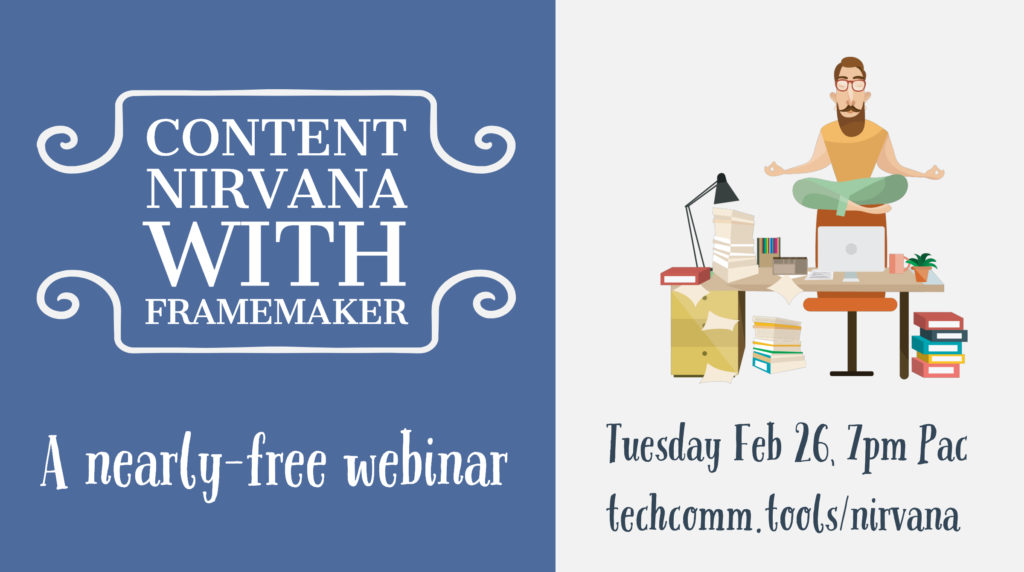
Achieving Content Nirvana with FrameMaker
Content nirvana: A state of content bliss, free from the repetitive effort and suffering associated with digital publishing and ad hoc formatting.
How to get there
The first step on this path is to understand where your time is currently being spent, and in particular, where you are spending time on things other than content creation and editing. That means accounting for the time you spend managing pagination, numbering, referencing, and text formatting.
If you’re interested in evaluating your own tech comm workflow, regardless of your current system or software, see my free Intro to FrameMaker online course. The first section of the course includes a self-assessment worksheet to help you understand the actual cost of various parts of your workflow. For a list of other options, see the end of this post.
While
I gave a webinar on Achieving Content Nirvana for STC-SD on February 26, 2019. You can access the recording here with a $5 donation to the STC-SD educational program.
I broke up the 1.25 hour session into the following sections, so you can use this outline as a general table of contents for the webinar recording itself.
Why you should care about structure
Structured content brings with it inherent benefits, but moving to a structured system can be somewhat expensive for small orgs, and payback on the initial investment may be up to a year or more.
However, when working in a solid structured environment you can expect to see economies of scale with respect to:
- Accuracy (especially related to maintaining consistent formatting and organization)
- Localization (translation into other languages)
- Compliance (contract requirements)
- SEO/Search (in internal systems, Google, or both)
The higher your annual expense in these areas, the faster you should be looking into migrating to structure, and FrameMaker works seamlessly with both structured and unstructured (paragraph-based) content.
Here’s an example of a structured document. See how you can follow the document’s content in the structure view, which helps you conform to the content model.

Online Help Output
While FrameMaker can be linked to RoboHelp in order to publish to online help systems, FrameMaker also contains essentially the same publishing engine. This means you can output directly from FrameMaker’s Publish pod and skip the step of maintaining and updating a RoboHelp project for this purpose.

Benefits of direct help output from FrameMaker include:
- Straightforward content editing using FrameMaker’s familiar interface
- Straightforward formatting of both PDF output and help output
- Fully customizable CSS if you want to go beyond the options in FrameMaker’s CSS GUI.
- Solid support for direct output of CSH (See https://techcommtools.com/csh/ for details)
Perfect PDF
FrameMaker has always produced fantastic PDF output, complete with bookmarks, embedded rich media, and automatically inserted interactive links. With FrameMaker 2019, there are a number of improvements to an already great system, including:
- 64-bit processing
- Intuitive setup via Publish pod
- Control over options
Sophisticated template management
In case you didn’t already know it, template management and a template-based workflow are perhaps the biggest reasons for using FrameMaker. Simply put, combining FrameMaker best practices with a well-designed template lets you easily and effectively:
- Separate content from formatting
- Easily control thousands of pages if needed
Scriptable environment
Another of my favorite FrameMaker labor savers are scripts and plugins. I almost always invest in a few scripts when working with a client on a workflow overhaul or a conversion from one format to another.
For those who enjoy writing code, the interface is straightforward, and for the rest of us, there is a robust community of folks that can help with existing tools for sale, or that can quickly create scripts to reduce the amount of handwork needed for tedious tasks.
My rule of thumb: If you expect a task to take more than 3 hours, you should consider having a script written instead.
Where to go from here
If you liked this post or enjoyed listening to the webinar, check out the following resources (all available on techcommtools.com) to help you move along that path to content nirvana!
Intro to FrameMaker course (Free)
Generously underwritten by Adobe, this course introduces you to FrameMaker and gives you what you might need to pick up and start making edits to existing FrameMaker documents. To register for the course, see the link on the FrameMaker 2019 welcome screen, or visit https://techcomm.tools/fm2019intro
Advanced Authoring online course
This course moves beyond the basic information in the Intro course and shows you how to create and edit sophisticated content.
See the course syllabus and other details at FrameMaker – Advanced Authoring
Template Design Workshop
This invaluable course begins by showing you how to evaluate your content and branding requirements and takes you all the way through producing a set of working templates.
See the course syllabus and other details at Framemaker – Template Design Workshop
The course:
- Explains how to format content for one or many authors
- Steps through creating all the formats needed for your template
Optimal time for thisonline course is 2 weeks to a month
FrameMaker – Working with Content reference book
In addition to this FrameMaker 2017 book, editions for FrameMaker 11 and FrameMaker 2015 are also available.
Structured Authoring workbook/course
Learn to work with an existing content model in a structured environment
Structured EDD Dev workbook/course
Learn to format a content model so that authors can easily and accurately create conforming structured content
On-Demand Online Meetings (including recordings)
See mattrsullivan.youcanbook.me if you need anywhere from 30 minutes to a few hours of help working out your options or solving issues in anything I do professionally.

Join over 4,300 of your peers and get my latest content sent to you for free, along with some of my all-time favorites.